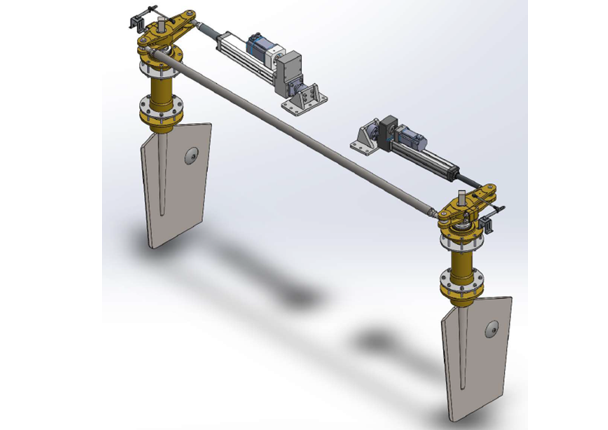Integrated Control System (ICS)
Integrated Control System (ICS)
ICS consist of
EMS
Energy Management System
SCS
Steering Control System
PCS
Propulsion Control System
PMS
Power Management System
ICS consist of
EMS
Energy Management System
PCS
Propulsion Control System
SCS
Steering Control System
PMS
Power Management System
Introduction to the Full Ship Control System (ICS)
For electric ships based on DC networking, whether using full electric systems or series/parallel hybrid systems, an Energy Management System (EMS) is required for energy distribution and control. If the power propulsion system uses an AC network, a Power Management System (PMS) is needed for synchronizing generator sets. The Propulsion Control System (PCS) manages the speed and direction of propulsion motors using control levers. Compared to hydraulic steering gears, our electric Steering Control System (SCS) is more energy efficient.
Introduction to the Full Ship Control System (ICS)
For electric ships based on DC networking, whether using full electric systems or series/parallel hybrid systems, an Energy Management System (EMS) is required for energy distribution and control. If the power propulsion system uses an AC network, a Power Management System (PMS) is needed for synchronizing generator sets. The Propulsion Control System (PCS) manages the speed and direction of propulsion motors using control levers. Compared to hydraulic steering gears, our electric Steering Control System (SCS) is more energy efficient.

Energy Management System (EMS)
The PLC-based Energy Management System (EMS) is a critical control system for electric ships. It collects data from all propulsion motors, generators, and inverters, and communicates with the Battery Management System (BMS), displaying all system parameters. The EMS controls inverters to manage battery charging and discharging modes and can switch hybrid motors between motor and generator modes. This system is easy to install and maintain, featuring remote software updates and diagnostics, and it integrates seamlessly with the ship’s monitoring and alarm systems, including an optional dynamic positioning system.
Energy Management System (EMS)

The PLC-based Energy Management System (EMS) is a critical control system for electric ships. It collects data from all propulsion motors, generators, and inverters, and communicates with the Battery Management System (BMS), displaying all system parameters. The EMS controls inverters to manage battery charging and discharging modes and can switch hybrid motors between motor and generator modes. This system is easy to install and maintain, featuring remote software updates and diagnostics, and it integrates seamlessly with the ship’s monitoring and alarm systems, including an optional dynamic positioning system.
Propulsion Control System (PCS)
The Propulsion Control System (PCS) is an integrated system designed to control and manage the propulsion systems of ships. The primary function of the PCS is to ensure the efficient, safe, and reliable operation of the ship's propulsion equipment, such as main engines, thrusters, and steering gears, thereby facilitating precise navigation control and optimized power output.
Our PCS is tailored for controlling various electric propulsion systems on ships, integrating intelligent display screens. The PCS can manage:
- Fixed Pitch Propeller
- Azimuth Thruster with top-mounted motor
- Parallel Hybrid Propulsion System
- Bow Thruster
- Rim-Driven Thruster, RIM

Propulsion Control System (PCS)

The Propulsion Control System (PCS) is an integrated system designed to control and manage the propulsion systems of ships. The primary function of the PCS is to ensure the efficient, safe, and reliable operation of the ship's propulsion equipment, such as main engines, thrusters, and steering gears, thereby facilitating precise navigation control and optimized power output.
Our PCS is tailored for controlling various electric propulsion systems on ships, integrating intelligent display screens. The PCS can manage:
- Fixed Pitch Propeller
- Azimuth Thruster with top-mounted motor
- Parallel Hybrid Propulsion System
- Bow Thruster
- Rim-Driven Thruster, RIM

Our propulsion control system adopts modular design and integration, meeting the propulsion needs of various electric ships, and includes functions such as remote-control system, speed/pitch display, azimuth display, and various hybrid mode switching.
The propulsion control system PCS can include the following components:
- PCS Control Lever
- PCS Control Panel
- PCS Dual Power Supply System
- PCS Controller (shared control box for each side and EMS)
- PCS Dual Power Supply System
- Non-Follow-Up Mode (alternate)
- Emergency Telegraph (alternate)
- RPM Display, Pitch Display, and Heading Angle Display

Our propulsion control system adopts modular design and integration, meeting the propulsion needs of various electric ships, and includes functions such as remote-control system, speed/pitch display, azimuth display, and various hybrid mode switching.
The propulsion control system PCS can include the following components:
- PCS Control Lever
- PCS Control Panel
- PCS Dual Power Supply System
- PCS Controller (shared control box for each side and EMS)
- PCS Dual Power Supply System
- Non-Follow-Up Mode (alternate)
- Emergency Telegraph (alternate)
- RPM Display, Pitch Display, and Heading Angle Display
Eletric Steering Control System (SCS)

The Steering Control System (SCS) is designed for controlling the operation of a ship's steering gear. The electric steering control system uses servo motors to control electric linear actuators, which in turn control the ship's rudder angle to achieve steering and course-keeping.
Our electric steering control system eliminates the need for traditional hydraulic pump stations. Instead, servo motors directly move the screw rods back and forth, generating significant torque while saving energy and reducing weight. The SCS system includes:
- One servo motor-controlled linear actuator with a ball valve coupling base, planetary gearbox, feedback device, and cable harness, powered by AC
- One servo motor-controlled linear actuator with a ball valve coupling base, planetary gearbox, feedback device, and cable harness, powered by DC
- Two electrical control boxes
- Two bridge display screens
- Rudder angle indicator
- Steering wheel
Eletric Steering Control System (SCS)
The Steering Control System (SCS) is designed for controlling the operation of a ship's steering gear. The electric steering control system uses servo motors to control electric linear actuators, which in turn control the ship's rudder angle to achieve steering and course-keeping.
Our electric steering control system eliminates the need for traditional hydraulic pump stations. Instead, servo motors directly move the screw rods back and forth, generating significant torque while saving energy and reducing weight. The SCS system includes:
- One servo motor-controlled linear actuator with a ball valve coupling base, planetary gearbox, feedback device, and cable harness, powered by AC
- One servo motor-controlled linear actuator with a ball valve coupling base, planetary gearbox, feedback device, and cable harness, powered by DC
- Two electrical control boxes
- Two bridge display screens
- Rudder angle indicator
- Steering wheel

Power Management System (PMS)

For electric ships without batteries, we provide AC grid-based power propulsion control systems. Taking the parallel hybrid power system as an example, the PTO motor is used as a generator for grid connection, which requires the Power Management System (PMS) to synchronize the grid connection. The synchronization conditions that need to be met are:
- Same Voltage
- Same Frequency
- Same Phase
Our electric steering control system eliminates the need for traditional hydraulic pump stations. Instead, servo motors directly move the screw rods back and forth, generating significant torque while saving energy and reducing weight. The SCS system includes:
- Parallel hybrid of AC networking
- Serial hybrid of AC networking
- Shaft generator + Battery
- Shaft generator grid connection (without battery)
Power Management System (PMS)
For electric ships without batteries, we provide AC grid-based power propulsion control systems. Taking the parallel hybrid power system as an example, the PTO motor is used as a generator for grid connection, which requires the Power Management System (PMS) to synchronize the grid connection. The synchronization conditions that need to be met are:
- Same Voltage
- Same Frequency
- Same Phase

Our electric steering control system eliminates the need for traditional hydraulic pump stations. Instead, servo motors directly move the screw rods back and forth, generating significant torque while saving energy and reducing weight. The SCS system includes:
- Parallel hybrid of AC networking
- Serial hybrid of AC networking
- Shaft generator + Battery
- Shaft generator grid connection (without battery)


